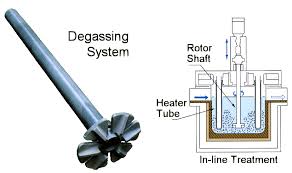Degassing Aluminum
The degassing unit is a special necessary purification equipment for the non-ferrous metal casting industry.
The alias is called: degassing unit, aluminum degassing unit, aluminum degassing equipment.
Degassing principle:
The rotary degasser breaks up large bubbles of inert gas into small bubbles by rotating at a high speed. The rotor sprays the inert gas and uniformly disperses it in the molten metal.
By reducing the diameter of the bubbles, the total surface area of these bubbles increases sharply, which causes more of the surface of the inert bubble to come into contact with hydrogen and impurities in the molten metal, bringing these harmful substances to the surface of the liquid.
The flow control into the inert gas of the aluminum liquid can adjust the gas’s flow rate according to the volume of the metal liquid to be treated, and the speed of the rotating rod and the rotor can be adjusted to generate bubbles of an appropriate size to facilitate the diffusion of the inert gas.

Both argon and nitrogen can be used as inert gases to degas the molten aluminum. The purity of the inert gas must be above 99.99%.
Degassing is the purpose of injecting an inert gas into molten aluminum to remove hydrogen.
Degassing is also considered to be a very effective way to float impurities.
Two main theoretical modes have been proposed to explain the principle of degassing.
a. The macro mode considers that the removal of each impurity is similar.
b. In the microscopic mode, that is, according to this theory, due to the higher vapor pressure of hydrogen, the dissolved hydrogen diffuses into the gas in the injected aluminum liquid. Theoretically, an inclusion having a diameter of 10 microns that contacts a bubble is adsorbed on the bubble and floats up to the surface of the liquid.














